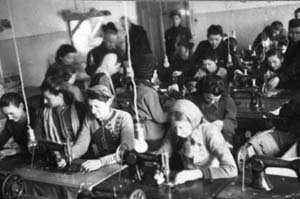
In Poland, the Nazi persecution of the Jews was concentrated at two main centers throughout the Second World War—Warsaw and Lodz. Both of those cities were transformed into large Jewish Ghettos which served as slave labor camps with the express intention of working the Jews to either death or until sent to one of the extermination camps. Although the Warsaw Ghetto was the larger of the two, Ghetto Lodz ran for a longer time, existing from February 1940 until it was liquidated in August 1944.1
In Lodz the persecution of the Jews began six month prior to the formation of the ghetto, on November 8, 1939, when the German army occupied the city.2 From that point the Nazi government enacted systematic laws for the isolation and repression of the Jews so as to reduce their ability to resist deportation and the eventual extermination.3 Another part of the germanization of Lodz involved renaming the city Litzmannstadt, after the German general who had captured the city during the First World War.4

With the order for segregating the Jewish community, 160,320 people were forced by the Germans into a space barely over four square miles. The following year that number was augmented by another 19,722 Jews from other German territories and 17,826 Jews from smaller ghettos in 1941. In addition to these numbers 5,007 Austrian Gypsies were also shipped to Ghetto Lodz, bringing the total number of slaves to nearly 200,000.5
One of the factors contributing to the longevity of the ghetto was the fact that the Jews, under the administration of Chaim Mordechaj Rumkowski, produced an enormous amount of goods for Germany.6 The primary industry of Lodz before the war was textiles, and as Litzmannstadt this continued to be true.7 During Arthur Greiser’s (the governor of the majority of occupied Poland) trial after the war he related that the “the Lodz Ghetto was one of the largest industrial centers in the Reich.”8 The rapid growth of its labor institutions revealed the truth of that statement:
The Lodz Ghetto excelled in the organization of its labor and its achievements in production. The production system in the ghetto, set in motion immediately after the ghetto was established, quickly expanded… The first sewing workshop went into operation in May 1940, and by September 1940 there were seventeen resorts including seven sewing factories… in 1942-1943, 95 percent of the adult population in the ghetto was working.9
 In order to fuel the rapid expansion of slave industry, Germany ordered Jewish possessions helpful to those ends to be shipped to Lodz from across the Reich. An example of this kind of edict from March 21, 1942, included a provision stating, “Sewing machines and manual machines are to be sent to Lodz (for the occupations by inhabitants of ghettos.)”10
In order to fuel the rapid expansion of slave industry, Germany ordered Jewish possessions helpful to those ends to be shipped to Lodz from across the Reich. An example of this kind of edict from March 21, 1942, included a provision stating, “Sewing machines and manual machines are to be sent to Lodz (for the occupations by inhabitants of ghettos.)”10
The machine pictured is one of those sewing machines used by the Jewish slaves in the Lodz Ghetto. It is a black Clemens-Muller brand treadle head which appears to have been originally branded as a Singer sewing machine. Engraved on the maintenance panel is the Star of David with the word getto within. Surrounding the star is the phrase Tekstil Abteilung Litzmannstadt. Altogether the inscription reads “Textile Division—Ghetto Litzmannstadt.” The Clemens-Muller base is 37 centimeter long and 18.5 centimeters wide. This sewing machine was most likely one of the 7,000 operational by the end of 1942 within the ghetto.11
 By August of 1944 the Russian army was steady approaching Poland and, with the success of the D-day invasion, defeat was fast approaching the Germans. This led to the final series of deportations from the Lodz Ghetto resulting in the murder of 67,000 Jews at Auschwitz. This, however, was only the last round of mass exterminations, with another 77,867 having been executed at the Chelmno death camp in the years prior—this includes the 15,681 children under 10 and elderly over 65 who were abducted on September 4, 1942. These numbers, added to the 45,327 people who died due to the inhuman conditions of the ghetto, means that out of the circa 200,000 Jews that were kept there, at least 190,194 of them died—a mortality rate of ~95%.12
By August of 1944 the Russian army was steady approaching Poland and, with the success of the D-day invasion, defeat was fast approaching the Germans. This led to the final series of deportations from the Lodz Ghetto resulting in the murder of 67,000 Jews at Auschwitz. This, however, was only the last round of mass exterminations, with another 77,867 having been executed at the Chelmno death camp in the years prior—this includes the 15,681 children under 10 and elderly over 65 who were abducted on September 4, 1942. These numbers, added to the 45,327 people who died due to the inhuman conditions of the ghetto, means that out of the circa 200,000 Jews that were kept there, at least 190,194 of them died—a mortality rate of ~95%.12
Below are pictures of the machine in the collection followed by several photos of the textile industry from the Lodz Ghetto.



















Endnotes
1 The Holocaust Encyclopedia, “Lodz” (Read here).
2 Centrum Dialogu, “The History of the Litzmannstadt Ghetto” (Read here).
3 The Holocaust Research Project “The Lodz Ghetto.”
4 Litzmannstadt Ghetto, “Introduction” (Read here).
5 The Holocaust Research Project “The Lodz Ghetto.”
6 Centrum Dialogu, “The History of Litzmannstadt Ghetto – The Ghetto Establishment” (Read here).
7 Litzmannstadt Ghetto, “Introduction” (Read here).
8 Isaiah Trunk, Lodz Ghetto: A History (Bloomington: Indiana University Press, 2006), p. xli. (Read here).
9 Ibid.
10 Edith Kurzweil, Nazi Laws and Jewish Lives: Letters from Vienna (New York: Routledge, 2004) (Read here).
11 Trunk, Lodz Ghetto, p. 150. (Read here).
12 Numbers from The Holocaust Research Project “The Lodz Ghetto.”
Still looking for answers? Visit our FAQ page
More Resources
Know the Truth and Protect Your Freedoms.
Still looking for answers? Visit our FAQ page
Stay Informed with the Latest Resources
Enter your email address to receive our regular newsletter, with important information and updates right in your inbox!










